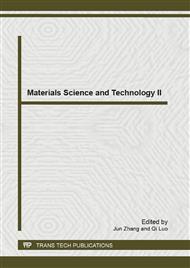[1]
D. F. Ross, Introduction to e-supply chain management: engaging technology to build market-winning business partnerships: St. Lucie Press, 2003.
DOI: 10.1201/9781420025415.fmatt
Google Scholar
[2]
N. M. Sadeh, et al., "MASCOT: An agent-based architecture for dynamic supply chain creation and coordination in the internet economy," Production Planning & Control, vol. 12, pp.212-223, 2001/01/01 2001.
DOI: 10.1080/095372801300107680
Google Scholar
[3]
P. Pontrandolfo, et al., "Global supply chain management: a reinforcement learning approach," International Journal of Production Research, vol. 40, pp.1299-1317, 2002.
DOI: 10.1080/00207540110118640
Google Scholar
[4]
J. M. Swaminathan, et al., "A Multi-Agent Framework for Modeling Supply Chain Dynamics," in Proceedings NSF Research Planning Workshop on Artificial Intelligence and Manufacturing, Albequerque, NM, 1996.
Google Scholar
[5]
J. Gjerdrum, et al., "A combined optimization and agent-based approach to supply chain modelling and performance assessment," Production Planning & Control, vol. 12, pp.81-88, 2001/01/01 2001.
DOI: 10.1080/09537280150204013
Google Scholar
[6]
M. Wooldridge, An introduction to multiagent systems: Wiley, 2002.
Google Scholar
[7]
T. Blecker and G. Graf, "Multi agent systems in internet based production environments—an enabling infrastructure for mass customization," in MCPC 2003, Munich, 2003.
Google Scholar
[8]
M. Wooldridge and N. R. Jennings, "Intelligent agents: Theory and practice," Knowledge engineering review, vol. 10, pp.115-152, 1995.
DOI: 10.1017/s0269888900008122
Google Scholar
[9]
M. Roboam, et al., "Enterprise Management Network Architecture," Integration, Artificial Intelligence Applications in Manufacturing, 1992.
Google Scholar
[10]
A. Saad, et al., "Performance evaluation of contract net-based heterarchical scheduling for flexible manufacturing systems," in IJCAI-95, Montreal, Canada, 1995, pp.310-321.
Google Scholar
[11]
M. Barbuceanu and M. S. Fox, "Integrating communicative action, conversations and decision theory to coordinate agents," in AAMAS-97, Marina del Rey, California, United States, 1997, pp.49-58.
DOI: 10.1145/267658.267667
Google Scholar
[12]
H. V. D. Parunak, et al., "The AARIA Agent Architecture: An Example of Requirements-Driven Agent-Based System Design," in Proceedings of the First International Conference on Autonomous Agents, Marina del Rey, CA, 1997.
DOI: 10.1145/267658.267777
Google Scholar
[13]
L. Wentao, "An Agent-Based Negotiation Model for the Sourcing Of the Condtruction Suppliers," PhD, The University of Hong Kong, Hong Kong, 2008.
Google Scholar
[14]
C. M. Bishop, Pattern recognition and machine learning vol. 4: springer New York, 2006.
Google Scholar
[15]
D. Rumelhart, et al., "Learning Internal Representations by Error Propagation, Parallel Distributed Processing, Explorations in the Microstructure of Cognition, ed. DE Rumelhart and J. McClelland. Vol. 1. 1986," ed: Cambridge, MA: MIT Press, 1986.
DOI: 10.7551/mitpress/4943.003.0042
Google Scholar
[16]
T. Yanar and Z. Akyüre, "Artificial Neural Networks as a Tool for Site Selection within GIS," Geodetic and Geographic Information Technologies, Natural and Applied Sciences, vol. 6531, 2007.
Google Scholar
[17]
O. Medelyan and I. H. Witten, "Thesaurus based automatic keyphrase indexing," in Proceedings of the 6th ACM/IEEE-CS joint conference on Digital libraries, 2006, pp.296-297.
DOI: 10.1145/1141753.1141819
Google Scholar
[18]
L. Rolling, "Indexing consistency, quality and efficiency," Information Processing & Management, vol. 17, pp.69-76, 1981.
DOI: 10.1016/0306-4573(81)90028-5
Google Scholar
[19]
O. Medelyan and I. H. Witten, "Thesaurus-based index term extraction for agricultural documents," in Proceedings of the 6th Agricultural Ontology Service (AOS) workshop at EFITA/WCCA, 2005.
Google Scholar


